When Halo 3: ODST was shown at E3 2009 I wasted no time preordering it, though I did have some minor reservations. I mean, the game was essentially a standalone expansion pack for Halo 3, a game which reasonably wrapped up the trilogy, and this game wouldn’t even feature the iconic Master Chief! Halo 3 was also 2 years old at this point, despite the undeniable staying power of its excellent multiplayer. Still, the reviews ended up being absolutely glowing, with the biggest criticism being the sticker price. Today ODST is still as celebrated for the interesting deviations it made from the core series as it was at release. On top of everything I’ll go into below, I also fondly look back on it for first introducing the “Firefight” gamemode, a “Horde mode” like cooperative wave survival mode that my brother became particularly enamored with.
Over 10 years later, I was able to easily play Halo 3: ODST again as part of the Master Chief Collection on my Xbox Series X. As with Halo 3’s MCC port, ODST didn’t receive the ridiculously thorough remaster treatment of the Halo: CE and Halo 2 anniversary editions, but the fact that it still looks so stunning today with little more than some upscaling speaks volumes about Bungie’s expertise. They were clearly at the top of their game with Halo 3: ODST, and it ages even better than Halo 3 as a result.
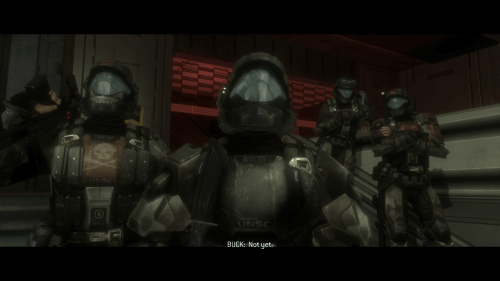
“The boys!”
Since so many of ODST’s gameplay elements are related to its story, and this is a side story taking place out of chronological order from the main series anyway, I’ll start by recapping the plot. Unlike Halo Wars, which took place before the events depicted in the main Halo games and has little direct relation to their plots, Halo 3: ODST actually takes place during events depicted in Halo 2. Aside from that, it is still very much its own story, however, and while I’m fairly vague in these plot summaries they absolutely do still contain spoilers, so skip the next paragraph if you want to avoid spoilage.
The Story: Breaching Earth’s defenses, the Prophet of Regret’s carrier has taken up position over New Mombasa while Covenant forces terrorize the city streets below. In a desperate move that could help turn the tide of the war, multiple squads of the UNSC’s elite Orbital Drop Shock Troopers (ODSTs) are ordered to drop onto the ship and capture the Covenant leader. ODST fireteam Alpha-9, led by Gunnery Sergeant Edward Buck, is attached to Office of Naval Intelligence officer Captain Veronica Dare for the assault. As the fireteam prepares to drop, Capt. Dare unexpectedly orders them to adjust their drop locations to land in the city instead. As they drop, Regret’s ship performs a surprise low orbit slipspace jump, resulting in a destructive shockwave that sends the fireteam’s drop pods wildly off course. The members of Alpha-9, now completely scattered, individually make their ways through the wreckage of the Covenant occupied mega-city to regroup. One of the members of the fireteam, picking up Dare’s radio signal and subtly guided by Vergil, the city’s Superintendent AI, locates Capt. Dare as she attempts to infiltrate the city’s underground data center. Upon reaching the data center’s core, Dare reveals the true purpose of her mission: to secure the Superintendent AI. The pair quickly discover that the Superintendent AI has been taken over by a Covenant defector. This Huragok, a rarely encountered species of alien dubbed “Engineers” which the Covenant use as biological supercomputers, could be extremely valuable in learning the purpose of Regret’s attack. Escorting this renegade Engineer back up to the surface and fending off multiple Covenant attacks along the way, they eventually meet up with Buck and the rest of his fireteam and make a hasty escape from the city.
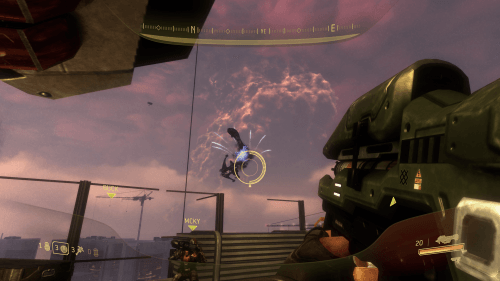
“Holding out against a ton of Covenant air with nothing but a huge pile of heavy weapons.”
Structurally, ODST plays unlike any other Halo game. You initially assume the role of the new member of the fireteam referred to as “the Rookie”. By the time the Rookie wakes up after his violent landing quite a few hours have passed and you’re tasked with wandering the dark, deserted streets of New Mombasa searching for signs of what happened to the rest of Alpha-9. Each of the clues you find results in a flashback mission switching you from your silent protagonist to one of his much more developed (and talkative) squadmates. These missions are structured more like your typical Halo mission and, taking place in different areas and at different times, allow Bungie to really mix up the scenery and the action. Once a mission is complete, you’re sent back to rejoin the Rookie in New Mombasa, with these sections ultimately functioning as something of an abstracted hub area. Very cool.
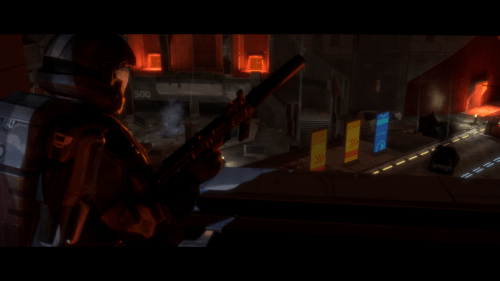
“The Rookie surveying the New Mombasa streets.”
The New Mombasa streets area has a couple of other interesting tricks up its sleeve. First, the expansive map is more or less wide open. While you’re guided to the location of each subsequent clue, it’s only by a waypoint, and there will be multiple ways to reach it. You’ll probably end up taking different routes whether you want to or not, as navigating the maze-like city streets isn’t easy, often requiring the use of the in-game map. Along the way you can choose whether to engage the Covenant patrols you encounter or attempt to sneak around them entirely. You can even find the aforementioned clues and play their associated missions totally out of order if you want to.
More importantly, these New Mombasa sections have an absolutely unique tone. As the Rookie, you’re all alone in the dark, rainy city streets. Remnants of the day’s earlier conflict surround you: ruined buildings, destroyed vehicles, and dead UNSC and Covenant soldiers alike. It conjures a lonely, bleak feeling. The Superintendent AI’s poltergeist-like attempts to guide you only add a further creepy layer to this. There’s also something of a light survival feel to these sections, as ammo is scarce; your UNSC weapons will probably be depleted after your first few encounters, forcing you to scrounge for Covenant weapons and ammo. The pacing is altered by all of this too. In the proceeding Halo games you’re shuffled from mission to mission with an urgency that is, I suppose, appropriate to the epic task at hand. You know, saving the planet and whatnot. In the New Mombasa streets, however, there is no such urgency. You’re just one person, completely isolated. It all feels very grounded and very personal.
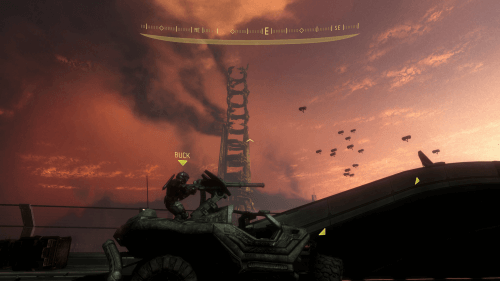
“A squadron of Banshees fly by the remains of the space elevator.”
The graphics and sound are a large component of why this all works. The lighting and shading certainly conjure a particular mood, but with ODST’s soundtrack they’ve incorporated a greatly expanded variety of different musical influences, from the more traditional Halo sounding orchestral tracks and electronic ambiance to smoky jazz-inspired, piano and saxophone laden pieces that sell the game’s intentionally film noir vibe. Halo has always had extremely strong soundwork, but ODST is really something else entirely. Anyone who thinks Marty O’Donnell is a one trick pony really needs to stop what they’re doing and go give the ODST soundtrack a listen. Right now!
Gameplay wise, Halo 3: ODST is built directly on top of Halo 3 and plays more or less the same, but it’s hard to mark the game down for that. I mean, that is one damn fine foundation. Some of the few differences between the two games relate to the fact that you’re not playing a literal supersoldier like Master Chief. I recall Bungie making statements before ODST’s release that perhaps oversold that just a little; that as a normal human, you’d be weaker and less capable and that suddenly even the previously laughable grunts would be fearsome opponents. That sort of thing. Instead, there is another new health system, this one feeling similar to Halo: CE’s with a shield-like recharging “stamina” layer and a core health pool that is only refilled with health packs. Unlike Halo: CE, however, these health packs are relatively plentiful. There’s also no hijacking vehicles, no dual wielding, no use of Halo 3’s special equipment, and no radar.
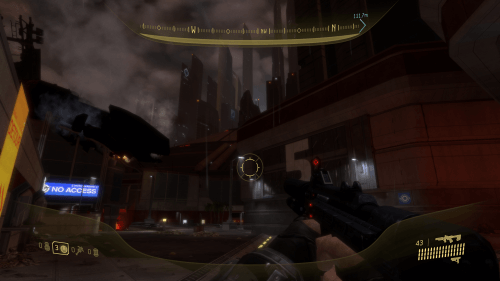
“New Mombasa Streets: VISR off.”
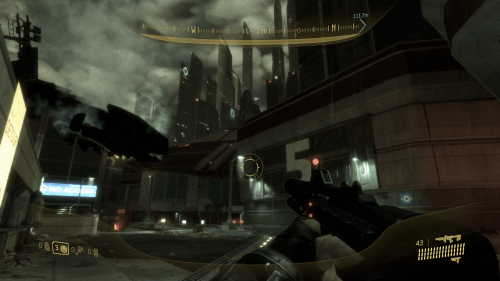
“New Mombasa Streets: VISR on.”
Bungie giveth as well. As an ODST your standard armaments are a new silenced version of the submachine gun and, something of a throwback to Halo: CE, a lovely new silenced magnum pistol. There’s also the VISR mode which serves as both a sort of night vision and also highlights friendlies, enemies, and certain objects with a thin colored outline on your HUD. The only negative to VSIR mode is that there’s no real reason to ever turn it off, and leaving it on means seeing only one, lesser version of the game’s lighting.
The VISR mode’s ability to highlight objects is key to ODST’s single collectible system: audio logs. Similar to the terminals of previous games, these logs are hidden throughout the New Mombasa streets. Interestingly, rather than typical voice memo type recordings, these are audio and still images recorded from security systems scattered around the city and tell the story of a single character, Sadie, and her attempt to meet up with her father as the fighting erupts. This story links directly into ODST’s overall plot, giving some insight into the Vergil AI and its fate. While I remember liking these audio logs, I could barely stand them this time around. The script feels unnatural and the voice acting and sound effects come across like a old time radio play. Sadie’s main nemesis in the story, the city’s police commissioner, is a particularly ridiculous mustache twirling villain stereotype that I just couldn’t take seriously.
At least that’s not an issue the campaign has! The voice cast is excellent, with notable TV actors including several of the core cast of Firefly with Nathan Fillion, who Buck is both voiced by and modeled after, and Battlestar Galactica’s Number Six, Tricia Helfer, voicing Veronica Dare. Say what you will about Buck’s sarcastic attitude or he and Dare’s relationship issues, but in the brief time we spend with these characters they express a lot more personality than we ever got from Master Chief, and the strong cast only helps that.
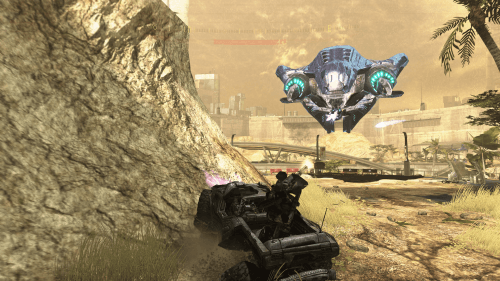
“Dutch’s level is a total throwback to previous games.”
I beat the game on “Heroic” difficulty, and even with the aforementioned lack of ammo and other constraints I found it to be one of the easiest campaigns so far. That’s not to say there weren’t some intense moments. The first time I ran into a Hunter I struggled like hell to take him down, depleting all of my grenades and most of my ammo in the process, only to have his buddy saunter into the room just as I was catching my breath. Sheer panic. There was also a lot more variety in the action than I’d remembered, with missions featuring a tank section, a wide open Warthog-centric level, some Banshee flying including a unique Scarab fight, and even yet another Warthog run-like level towards the end of the game. Even with its relatively short length, there’s definitely enough to make it feel like a full Halo game. While a part of me does have to wonder if you had to have played the previous games in the franchise to really appreciate it to its full extent, I personally think Halo 3: ODST is something of a masterpiece and is easily one of the strongest games in the series.
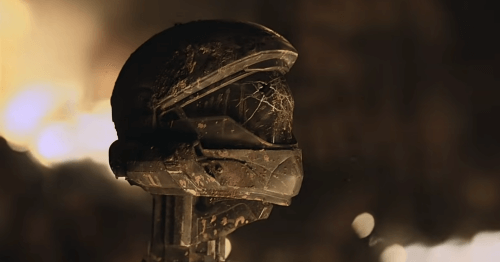
“We are ODST!”
Just a quick footnote, but similar to Halo 3’s “Landfall”, ODST’s considerable promotion efforts included the absolutely awesome The Life. This live-action short shows the journey of an ODST from a young recruit to a battle hardened veteran. Compelling and absolutely worth a quick watch if you’re a Halo fan and haven’t seen it!